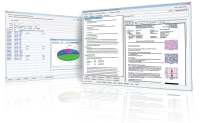 Microcsopic section of human kidney.CAP requires tissue processor validation
Microcsopic section of human kidney.CAP requires tissue processor validation
BY WILLIAM DESALVO, BS HTL(ASCP)
On July 17, 2013, Gerald A. Hoeltge, MD, FCAP, chair, Checklists Committee, College of American Pathologists (CAP), presented a webinar titled “2013 Continuing Compliance Master Series, Checklist Updates for Anatomic Pathology,” detailing the changes and additions coming to anatomic pathology in 2014.
Within that presentation, two important guidelines were discussed that, I believe, will create a major improvement to patient sample quality, drive interoperable (lab-to-lab) standardization and support the use of the Six Sigma method, improve the quality of process outputs (the patient tissue slide) by identifying and removing the causes of defects (errors), and minimize variability in the histology laboratory. These guidelines are ANP. 23120 Tissue Processing Programs Phase II, Tissue processing programs are validated; and ANP. 23045 Instrument/Equipment performance Phase II, The performance of all instruments and equipment is verified before use.
What a great leap for quality.
In recent years, histotechnology and clinical histology laboratories have struggled to replace an old and antiquated technical process model that creates multiple obstacles to quality improvement, patient safety, and cost reduction. The current tissue sample processing model and how it is often applied frequently promotes reactive adjustments to variation; waiting for the pathologist to review the final patient sample slide after completion of the technical process and communicate to the laboratory any unacceptable variations. Now there is regulatory support to create a new tissue sample process, using Six Sigma methods, to create a protocol that requires all clinical histology laboratories to start their technical process with a defined validation protocol that will confirm the tissue sample processing meets essential quality elements necessary to move from reactive to proactive adjustments. We must improve our process to the point that we all obtain consistent, reliable, reproducible, and accurately processed samples. To take the leap forward in quality and avoid back steps, I believe, we will need to concentrate on these essential elements:
- accuracy;
- precision; and
- evaluation.
Big leap for quality: accuracy

There will be need to document two essential time stamps to complete the validation protocol: removal of the tissue sample (cold ischemia time, now required for breast tissue samples), and placement of the tissue sample in fixative. These times are not impossible to collect, but they must now be collected for every tissue sample submitted for processing. The only required guideline for recording the cold ischemia time for a tissue sample is associated with breast tissue samples (ASCO/CAP guidelines) that will require ER/PR/Her2 testing, no longer than 1 hour, or results may be invalid.
There will need to be discussion, consensus, and publication by tissue type guidelines for the histology laboratory to increase accuracy. This may sound over-reaching, but if cold ischemia time is critical for breast tissue samples, then why is it not critical for all tissue samples, or at least diagnostic samples? It is not always easy to determine and identify which tissue sample will require testing beyond routine and need a specific and sensitive test (ie, immunohistochemistry or molecule) to allow the development of a diagnosis by the pathologist.
To ensure these changes in collection of tissue samples take place, the histology lab personnel and pathologist will have to become more involved in communicating requirements, training, and monitoring the multiple collection locations. This issue could create the need to take one or two steps backward—or at least a pause—before we leap.
New methods and tools: precision

What is the correct sample size? What is the correct sample thickness? The request for sample and thickness size standardization has been an issue for the past several years, and now, with regulatory support, we can finally move to all labs using specific dissection tools, invented and produced by multiple vendors, to produce consistent and compliant tissue samples.
Let’s not miss the opportunity to create interoperability and increased standardization, and establish narrow parameters for size and thickness. There are multiple factors to consider. To be successful, again, there must be discussion and consensus. I believe the discussion should start with thickness being 3 millimeters or less (accommodates conventional, microwave, and rapid tissue processing), and size no longer or wider than 15 millimeters.
After sample collection has been accomplished, there is another critical step to completing the precision element: fixation. The needs and requirements are well known, but there remains a wide—I believe too wide—variation in the time tissue samples are in fixative. What is the correct time? What are the acceptable limits of variation? The ASCO/CAP guideline for breast tissue samples, the only published guideline that provides a specific time range and requires compliance to report results, is very wide. We must not allow this range to adversely affect the tissue processing protocol. It was developed before the start of the tissue processing validation protocol and now must become part of the tissue processing protocol. The grossing personnel must continue to be essential to the process, but they must take more responsibility for compliance of precision and be willing to partner with, and become a more integral member of, the histology lab. Collection, sampling, and fixation starts and ends in the gross room. Let’s jump this hurdle now and keep quality moving forward.

Here we have many hurdles, and we cannot sidestep any of them. We now produce superior quality and excellent patient results; let’s take the opportunity to leap again by improving standardization and interoperability.
Establishing parameters for review: evaluation
There are many more quality elements of the validation protocol that will need to be addressed, but I think it is critical to discuss evaluation of validation results. CAP again provides guidance: The validation samples (slides) should be evaluated by the pathologist without knowledge of which processing program was used and graded on quality of section and staining. This is blind review, and it is most critical to the validation protocol. Without blind review, the prejudice of the reviewer—both positive and negative—will affect the quality of the data collected. Before slides are presented for review, there will need to be a little more work performed; parameters for review must be established. This is an area that often gets overlooked or is not well-defined in the histology lab. There are usually multiple personnel performing the technical process and multiple pathologists reviewing slides, creating multiple levels of acceptable quality built into the process. Now is the time to reduce variation and, ultimately, improve quality. This is where we have the chance to take back a few of the backward steps. Developing and using a proper blind review protocol will help everyone involved in the process understand the exact quality standard desired. Until every histology lab has a narrowly defined acceptable quality standard, we will never be able to take the leap CAP has presented. Not just a step backward, no leap at all.

Ask yourself: To achieve quality gains (gains for all; technicians, technologists, pathologists, pathologists’ assistants, and, most importantly, the patient) by developing and performing a validation protocol for tissue sample processing, what will you need to do to maintain the success? What part of the process will you be involved in? What type of quality control plan will you need to develop? What else can you do? Take this leap now, and you will find quality process improvement comes in many shapes and sizes. It may have different names, but it always has a common goal: to improve and assure the safety, quality, and cost-efficiency of the clinical histology laboratory.
William DeSalvo, BS HTL(ASCP), is a contributing writer for CLP. DeSalvo serves as the AP system production manager for Sonora Quest Laboratories, Tempe, Ariz; he is a member of the Digital Pathology Association’s executive board; chair of the National Society for Histotechnology quality management committee; and owner/consultant, Collaborative Advantage Consulting, Phoenix. For more information, contact Editor Judy O’Rourke, [email protected].





